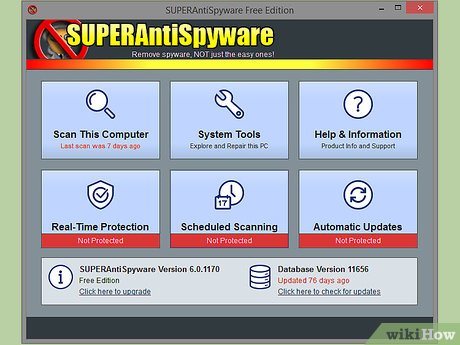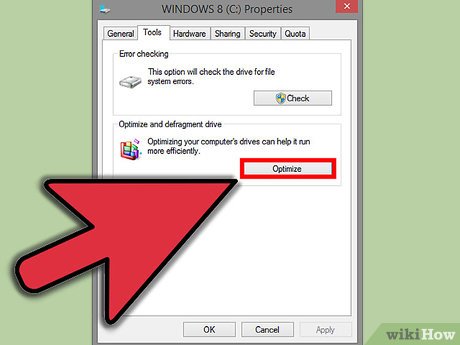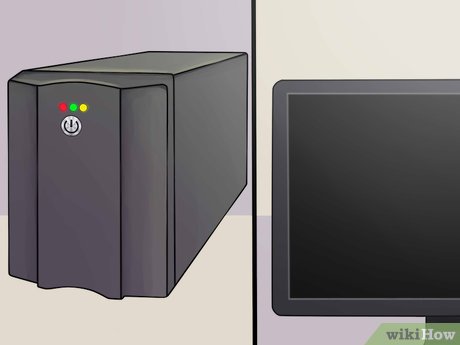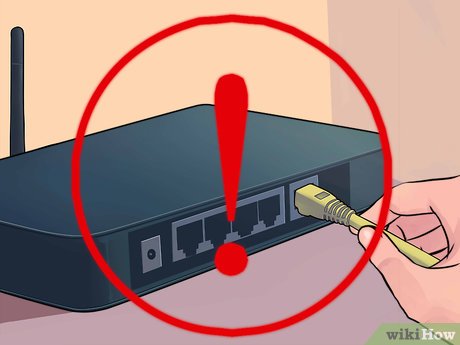How to Maintain Your Computer
Method 1 of 2:
Software/Hard Drive
-
 Clean out all the junk left behind by browsers. To do this, you can use the Disk Cleanup utility included on Windows, or you can download a freeware program such as CCleaner to do it for you. In Linux you can use Kleansweep or Bleachbit. Cookies and cache left behind by browsers can add up to gigabytes of wasted space, so it is imperative they're deleted.
Clean out all the junk left behind by browsers. To do this, you can use the Disk Cleanup utility included on Windows, or you can download a freeware program such as CCleaner to do it for you. In Linux you can use Kleansweep or Bleachbit. Cookies and cache left behind by browsers can add up to gigabytes of wasted space, so it is imperative they're deleted. -
 Search for and destroy spyware and/or viruses on your PC. There is a myriad of tools available to do this. Avast is a good one to use.
Search for and destroy spyware and/or viruses on your PC. There is a myriad of tools available to do this. Avast is a good one to use. -
 Defrag your hard drive to keep your computer running smoothly. Windows XP and up includes a utility to do this, and Windows Vista and up will automatically defrag your hard drive once a week.[1]
Defrag your hard drive to keep your computer running smoothly. Windows XP and up includes a utility to do this, and Windows Vista and up will automatically defrag your hard drive once a week.[1] -
 Uninstall programs you no longer use, and delete music you no longer listen to. You'll be surprised how much space you'll free up.
Uninstall programs you no longer use, and delete music you no longer listen to. You'll be surprised how much space you'll free up. -
 Control what programs are allowed to run at startup. This can greatly reduce your startup times.
Control what programs are allowed to run at startup. This can greatly reduce your startup times.- In Windows 8 and 10, open the task manager, then select the Startup tab.
- On Windows XP, Vista, and 7, open command prompt, then type "msconfig". Once msconfig opens, then select the Startup tab.
- CCleaner also has a feature that allows you to do the same thing (Tools--->Startup)
-
 Use your computer's disk management systems.
Use your computer's disk management systems.- For Windows, select Performance and Maintenance and then choose "Rearrange items on your hard disk..." and "Free up space on your hard disk."
- For Mac, go to the Applications Folder, select Utilities Folder then launch Disk Utility.
Method 2 of 2:
Hardware/CPU
-
 Always run your computer on a UPS as this will help protect it from electric surges. Phone lines for modems and cat 5 or cat 6 network lines also need surge suppression as they can and will take out your network card or modem in an electric storm.
Always run your computer on a UPS as this will help protect it from electric surges. Phone lines for modems and cat 5 or cat 6 network lines also need surge suppression as they can and will take out your network card or modem in an electric storm. -
 Clean your computer. Your computer can grow dusty in less than a year, depending on where it is stored. Open it up depending on how dusty your house is. If it's not too dusty, then check every few months, but if it's super dusty (your house), then be much more proactive about it. Remove the dust on the bottom with a vacuum (or cloth), then spray with compressed canned air. Pay special attention to the CPU heat sink and CPU fan. Hold the fan still while spraying it as you can cause it to spin out and on reboot it may have more noise. Spray the intakes to the Power supply fan also. Since you have the cover off reboot and listen for noisy fans make sure all fans are working. Replace the fan if it stops spinning or starts making unnatural sound or you can try to lubricate the bearing, this might help.
Clean your computer. Your computer can grow dusty in less than a year, depending on where it is stored. Open it up depending on how dusty your house is. If it's not too dusty, then check every few months, but if it's super dusty (your house), then be much more proactive about it. Remove the dust on the bottom with a vacuum (or cloth), then spray with compressed canned air. Pay special attention to the CPU heat sink and CPU fan. Hold the fan still while spraying it as you can cause it to spin out and on reboot it may have more noise. Spray the intakes to the Power supply fan also. Since you have the cover off reboot and listen for noisy fans make sure all fans are working. Replace the fan if it stops spinning or starts making unnatural sound or you can try to lubricate the bearing, this might help. -
 Be careful when plugging in USB, Ethernet, speakers, printer etc. into your computer. Ports such as USB and Ethernet can easily be damaged from careless placement. These repairs can be costly, and these ports are a necessity.
Be careful when plugging in USB, Ethernet, speakers, printer etc. into your computer. Ports such as USB and Ethernet can easily be damaged from careless placement. These repairs can be costly, and these ports are a necessity.
5 ★ | 1 Vote
You should read it
- What is a disk signature? Fix disk signature conflict error
- Know about bad sectors on your hard drive
- How to Create Disk Images with Disk Utility (Mac OS)
- How to Free up Hard Disk Space on Windows Vista
- What is RAM Disk? How does it work?
- Here's how to create a Virtual Hard Disk on Windows 10
- 7 tools to increase hard drive performance on Windows
- Hard Disk Sentinel - Download Hard Disk Sentinel here
May be interested
- How to use and maintain the Gas stove
 gas stoves can cause fire and explosion if you use them carelessly and do not store them properly
gas stoves can cause fire and explosion if you use them carelessly and do not store them properly - How to Become an IT Manager
 an information technology (it) manager is in charge of the employees that install and maintain computer systems, including software and wireless networks, for companies and organizations. they are involved in both the technical and...
an information technology (it) manager is in charge of the employees that install and maintain computer systems, including software and wireless networks, for companies and organizations. they are involved in both the technical and... - How to turn off laptop screen but still keep the computer running on Windows 10
 sometimes you want to turn off your computer screen when resting but still maintain the operation, or more specifically, gamers who play online and want to save battery? but how many people know how to turn off the laptop screen but the computer is still working?
sometimes you want to turn off your computer screen when resting but still maintain the operation, or more specifically, gamers who play online and want to save battery? but how many people know how to turn off the laptop screen but the computer is still working? - Tips on simple ways to clean your PC with TipsMake!
 learn how to clean your pc effectively and important notes when cleaning your computer to help maintain and ensure your pc always operates stably.
learn how to clean your pc effectively and important notes when cleaning your computer to help maintain and ensure your pc always operates stably. - How to Maintain the Speed of a Freshly Installed Windows OS
 want to maintain the speed of your freshly installed windows os? here are some tips for you to follow. basic idea on windows registry(not in detail, just know what it is, and the consequences of editing it in a wrong manner). backup the...
want to maintain the speed of your freshly installed windows os? here are some tips for you to follow. basic idea on windows registry(not in detail, just know what it is, and the consequences of editing it in a wrong manner). backup the... - Instructions for changing Pagefile size and position on Windows
 although pagefile.sys takes up a large amount of space on your drive, the computer uses it to maintain important data stored on the computer instead of having to delete this data when ram is overloaded.
although pagefile.sys takes up a large amount of space on your drive, the computer uses it to maintain important data stored on the computer instead of having to delete this data when ram is overloaded. - Top 10 indispensable apps that help you stay focused
 in modern life today there are many factors both objective and subjective that make it difficult to maintain concentration. here are the top 10 indispensable apps that help maintain focus. invite you to consult!
in modern life today there are many factors both objective and subjective that make it difficult to maintain concentration. here are the top 10 indispensable apps that help maintain focus. invite you to consult! - How to maintain beautiful wooden furniture like new
 proper use and maintenance of wooden furniture will help the wooden items always be shiny as new and not damaged.
proper use and maintenance of wooden furniture will help the wooden items always be shiny as new and not damaged. - Backup all Gmail messages to your computer, Download google emails to your computer
 the following article shows how to back up all messages on gmail.com on your computer, download google mail to your computer, so that you can maintain and protect data safely and for the longest.
the following article shows how to back up all messages on gmail.com on your computer, download google mail to your computer, so that you can maintain and protect data safely and for the longest. - Want to become rich, remember to maintain 15 routine habits below!
 'daily habits can show how you will succeed or fail in the future'. if you want to be rich, remember to maintain 15 daily habits below!
'daily habits can show how you will succeed or fail in the future'. if you want to be rich, remember to maintain 15 daily habits below!













 How to Install Video Drivers
How to Install Video Drivers How to Establish Nvidia SLI
How to Establish Nvidia SLI How to Disable BIOS Memory Options
How to Disable BIOS Memory Options How to Unpartition a Hard Drive
How to Unpartition a Hard Drive How to Find and Update Drivers
How to Find and Update Drivers How to Ground Yourself to Avoid Destroying a Computer with Electrostatic Discharge
How to Ground Yourself to Avoid Destroying a Computer with Electrostatic Discharge